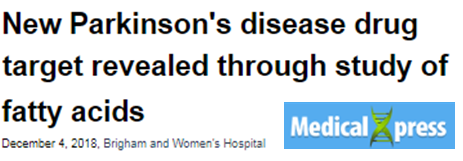HYPE?
Media portrayal:

HOPE?
Scientific interpretation:
SCD: a new molecular target for Parkinson’s disease modification
Original article: Lipidomic Analysis of a-Synuclein Neurotoxicity Identifies Stearoyl CoA Desaturase as a Target for Parkinson Treatment, Molecular Cell: 2019.
The takeaway
Alpha synuclein interacts with lipids inside neurons. When lipids are not handled properly, they can increase the toxicity of alpha synuclein. Targeting a key enzyme in this lipid handling process, SCD, was shown to reduce the accumulation of harmful alpha synuclein, indicating this could be a promising target for disease modification.
Why is it important?
This work focuses on lipid handing as one of the crucial processes for neuron survival and identifies an enzyme that can be targeted with potential disease modifying implications.
%
IMPACT
- Novelty 95%
- Proximity 60%
- Deliverability 60%
Impact Opinion
“This is a very interesting new study that is not only opening a new area of research for the Parkinson’s community, but also providing novel therapeutic pathways that are already being explored by biotech firms for clinical translation. The inhibition of SCD, however, may be difficult to take to the clinic as SCD is known to have very different functions in different tissues (while it may be beneficial in neurons that have too much alpha synuclein, it could be detrimental in other types of cells in different parts of the body). Thus, a targetted approach (and some caution) is required with efforts to translate these findings to the clinic.”
Background
The brain is the second most lipid-rich organ. Lipids play many important roles in the way neurons develop and communicate with each other. One of the main ways in which lipids are prevented from causing damage in cells is by storing them in the form of triglycerides that make up lipid droplets. Alpha synuclein, a protein which when abnormal causes major damage to neurons in Parkinson’s, normally interacts with lipids. In addition, there is some evidence to suggest that lipid metabolism is one of the key pathological mechanisms underlying the condition. Yet the nature of the ways in which alpha synuclein interacts with lipids inside cells is not well understood.
To address this complex question, these researchers used cells from different organisms (yeast, rodent and human), investigated a roundworm model of dopamine neurodegeneration, stem cell derived and Parkinson’s patient derived neurons as well as a mouse model of familial Parkinson’s.
The details
First, they found that misfolded alpha synuclein caused problems in lipid handling within yeast cells, leaving excess compounds free in the cell. They then found that one of these, a monounsaturated fat called oleic acid, made alpha synuclein even more toxic to the cell when it was not stored appropriately. They replicated these observations in rat and human neurons, and showed also that preventing the formation of oleic acid reduced the harmful effects of alpha synuclein.
When they addressed the impact of these effects in a mouse model of familial Parkinson’s, the animals exhibited significant movement problems on various tests (indicating this is a valid model), and neurons from these animals also showed abnormal lipid composition. In human cells, these researchers also demonstrated that when they targeted Stearoyl CoA Desaturase (SCD), which is the enzyme that produces oleic acid, by genetic manipulation or using a drug, the number of alpha synuclein clumps inside neurons was reduced. As alpha synuclein can come in many forms, they also found that inhibiting SCD reduced the relative amount of the harmful, monomeric form of alpha synuclein compared to the harmless tetrameric form.
Next steps
Having identified a new potential target for synucleinopathies, one of which is Parkinson’s, the next step is to develop and investigate a safe and efficacious means of inhibiting SCD in further animal models and demonstrating symptom improvement. Depending on these results, this line of research may then be taken further into human trials.
Related work and trials
See other work on targeting lipids
Original article: Lipidomic Analysis of a-Synuclein Neurotoxicity Identifies Stearoyl CoA Desaturase as a Target for Parkinson Treatment, Molecular Cell: 2019.



